+ Open data
Open data
- Basic information
Basic information
| Entry | Database: PDB / ID: 7kkk | ||||||
|---|---|---|---|---|---|---|---|
| Title | SARS-CoV-2 Spike in complex with neutralizing nanobody Nb6 | ||||||
 Components Components |
| ||||||
 Keywords Keywords | VIRAL PROTEIN/IMMUNE SYSTEM / Complex / Nanobody / VHH / VIRAL PROTEIN-IMMUNE SYSTEM complex | ||||||
| Function / homology |  Function and homology information Function and homology informationsymbiont-mediated disruption of host tissue / Maturation of spike protein / Translation of Structural Proteins / Virion Assembly and Release / host cell surface / host extracellular space / viral translation / symbiont-mediated-mediated suppression of host tetherin activity / Induction of Cell-Cell Fusion / structural constituent of virion ...symbiont-mediated disruption of host tissue / Maturation of spike protein / Translation of Structural Proteins / Virion Assembly and Release / host cell surface / host extracellular space / viral translation / symbiont-mediated-mediated suppression of host tetherin activity / Induction of Cell-Cell Fusion / structural constituent of virion / membrane fusion / entry receptor-mediated virion attachment to host cell / Attachment and Entry / host cell endoplasmic reticulum-Golgi intermediate compartment membrane / positive regulation of viral entry into host cell / receptor-mediated virion attachment to host cell / host cell surface receptor binding / symbiont-mediated suppression of host innate immune response / receptor ligand activity / endocytosis involved in viral entry into host cell / fusion of virus membrane with host plasma membrane / fusion of virus membrane with host endosome membrane / viral envelope / symbiont entry into host cell / virion attachment to host cell / SARS-CoV-2 activates/modulates innate and adaptive immune responses / host cell plasma membrane / virion membrane / identical protein binding / membrane / plasma membrane Similarity search - Function | ||||||
| Biological species |  synthetic construct (others) | ||||||
| Method | ELECTRON MICROSCOPY / single particle reconstruction / cryo EM / Resolution: 3.03 Å | ||||||
 Authors Authors | Schoof, M.S. / Faust, B.F. / Saunders, R.A. / Sangwan, S. / Rezelj, V. / Hoppe, N. / Boone, M. / Billesboelle, C.B. / Puchades, C. / Azumaya, C.M. ...Schoof, M.S. / Faust, B.F. / Saunders, R.A. / Sangwan, S. / Rezelj, V. / Hoppe, N. / Boone, M. / Billesboelle, C.B. / Puchades, C. / Azumaya, C.M. / Kratochvil, H.T. / Zimanyi, M. / Desphande, I. / Liang, J. / Dickinson, S. / Nguyen, H.C. / Chio, C.M. / Merz, G.E. / Thompson, M.C. / Diwanji, D. / Schaefer, K. / Anand, A.A. / Dobzinski, N. / Zha, B.S. / Simoneau, C.R. / Leon, K. / White, K.M. / Chio, U.S. / Gupta, M. / Jin, M. / Li, F. / Liu, Y. / Zhang, K. / Bulkley, D. / Sun, M. / Smith, A.M. / Rizo, A.N. / Moss, F. / Brilot, A.F. / Pourmal, S. / Trenker, R. / Pospiech, T. / Gupta, S. / Barsi-Rhyne, B. / Belyy, V. / Barile-Hill, A.W. / Nock, S. / Liu, Y. / Krogan, N.J. / Ralston, C.Y. / Swaney, D.L. / Garcia-Sastre, A. / Ott, M. / Vignuzzi, M. / Walter, P. / Manglik, A. / QCRG Structural Biology Consortium | ||||||
| Funding support |  United States, 1items United States, 1items
| ||||||
 Citation Citation |  Journal: Science / Year: 2020 Journal: Science / Year: 2020Title: An ultrapotent synthetic nanobody neutralizes SARS-CoV-2 by stabilizing inactive Spike. Authors: Michael Schoof / Bryan Faust / Reuben A Saunders / Smriti Sangwan / Veronica Rezelj / Nick Hoppe / Morgane Boone / Christian B Billesbølle / Cristina Puchades / Caleigh M Azumaya / Huong T ...Authors: Michael Schoof / Bryan Faust / Reuben A Saunders / Smriti Sangwan / Veronica Rezelj / Nick Hoppe / Morgane Boone / Christian B Billesbølle / Cristina Puchades / Caleigh M Azumaya / Huong T Kratochvil / Marcell Zimanyi / Ishan Deshpande / Jiahao Liang / Sasha Dickinson / Henry C Nguyen / Cynthia M Chio / Gregory E Merz / Michael C Thompson / Devan Diwanji / Kaitlin Schaefer / Aditya A Anand / Niv Dobzinski / Beth Shoshana Zha / Camille R Simoneau / Kristoffer Leon / Kris M White / Un Seng Chio / Meghna Gupta / Mingliang Jin / Fei Li / Yanxin Liu / Kaihua Zhang / David Bulkley / Ming Sun / Amber M Smith / Alexandrea N Rizo / Frank Moss / Axel F Brilot / Sergei Pourmal / Raphael Trenker / Thomas Pospiech / Sayan Gupta / Benjamin Barsi-Rhyne / Vladislav Belyy / Andrew W Barile-Hill / Silke Nock / Yuwei Liu / Nevan J Krogan / Corie Y Ralston / Danielle L Swaney / Adolfo García-Sastre / Melanie Ott / Marco Vignuzzi / / Peter Walter / Aashish Manglik /   Abstract: The severe acute respiratory syndrome coronavirus 2 (SARS-CoV-2) virus enters host cells via an interaction between its Spike protein and the host cell receptor angiotensin-converting enzyme 2 (ACE2). ...The severe acute respiratory syndrome coronavirus 2 (SARS-CoV-2) virus enters host cells via an interaction between its Spike protein and the host cell receptor angiotensin-converting enzyme 2 (ACE2). By screening a yeast surface-displayed library of synthetic nanobody sequences, we developed nanobodies that disrupt the interaction between Spike and ACE2. Cryo-electron microscopy (cryo-EM) revealed that one nanobody, Nb6, binds Spike in a fully inactive conformation with its receptor binding domains locked into their inaccessible down state, incapable of binding ACE2. Affinity maturation and structure-guided design of multivalency yielded a trivalent nanobody, mNb6-tri, with femtomolar affinity for Spike and picomolar neutralization of SARS-CoV-2 infection. mNb6-tri retains function after aerosolization, lyophilization, and heat treatment, which enables aerosol-mediated delivery of this potent neutralizer directly to the airway epithelia. | ||||||
| History |
|
- Structure visualization
Structure visualization
| Movie |
 Movie viewer Movie viewer |
|---|---|
| Structure viewer | Molecule:  Molmil Molmil Jmol/JSmol Jmol/JSmol |
- Downloads & links
Downloads & links
- Download
Download
| PDBx/mmCIF format |  7kkk.cif.gz 7kkk.cif.gz | 1.1 MB | Display |  PDBx/mmCIF format PDBx/mmCIF format |
|---|---|---|---|---|
| PDB format |  pdb7kkk.ent.gz pdb7kkk.ent.gz | 939.9 KB | Display |  PDB format PDB format |
| PDBx/mmJSON format |  7kkk.json.gz 7kkk.json.gz | Tree view |  PDBx/mmJSON format PDBx/mmJSON format | |
| Others |  Other downloads Other downloads |
-Validation report
| Summary document |  7kkk_validation.pdf.gz 7kkk_validation.pdf.gz | 2 MB | Display |  wwPDB validaton report wwPDB validaton report |
|---|---|---|---|---|
| Full document |  7kkk_full_validation.pdf.gz 7kkk_full_validation.pdf.gz | 2 MB | Display | |
| Data in XML |  7kkk_validation.xml.gz 7kkk_validation.xml.gz | 99 KB | Display | |
| Data in CIF |  7kkk_validation.cif.gz 7kkk_validation.cif.gz | 150.4 KB | Display | |
| Arichive directory |  https://data.pdbj.org/pub/pdb/validation_reports/kk/7kkk https://data.pdbj.org/pub/pdb/validation_reports/kk/7kkk ftp://data.pdbj.org/pub/pdb/validation_reports/kk/7kkk ftp://data.pdbj.org/pub/pdb/validation_reports/kk/7kkk | HTTPS FTP |
-Related structure data
| Related structure data |  22907MC 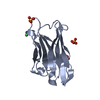 7kkjC  7kklC M: map data used to model this data C: citing same article ( |
|---|---|
| Similar structure data |
- Links
Links
- Assembly
Assembly
| Deposited unit | 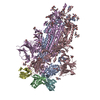
|
|---|---|
| 1 |
|
- Components
Components
| #1: Protein | Mass: 142399.375 Da / Num. of mol.: 3 Source method: isolated from a genetically manipulated source Source: (gene. exp.)  Gene: S, 2 / Cell line (production host): ExpiCHO / Production host:  #2: Antibody | Mass: 12696.166 Da / Num. of mol.: 3 Source method: isolated from a genetically manipulated source Source: (gene. exp.) synthetic construct (others) / Plasmid: pET26b / Production host:  #3: Polysaccharide | 2-acetamido-2-deoxy-beta-D-glucopyranose-(1-4)-2-acetamido-2-deoxy-beta-D-glucopyranose Source method: isolated from a genetically manipulated source #4: Sugar | ChemComp-NAG / Has ligand of interest | N | Has protein modification | Y | |
|---|
-Experimental details
-Experiment
| Experiment | Method: ELECTRON MICROSCOPY |
|---|---|
| EM experiment | Aggregation state: PARTICLE / 3D reconstruction method: single particle reconstruction |
- Sample preparation
Sample preparation
| Component |
| ||||||||||||||||||||||||
|---|---|---|---|---|---|---|---|---|---|---|---|---|---|---|---|---|---|---|---|---|---|---|---|---|---|
| Molecular weight | Experimental value: NO | ||||||||||||||||||||||||
| Source (natural) |
| ||||||||||||||||||||||||
| Source (recombinant) |
| ||||||||||||||||||||||||
| Buffer solution | pH: 8 | ||||||||||||||||||||||||
| Specimen | Embedding applied: NO / Shadowing applied: NO / Staining applied: NO / Vitrification applied: YES | ||||||||||||||||||||||||
| Specimen support | Grid material: GOLD / Grid mesh size: 300 divisions/in. / Grid type: Quantifoil | ||||||||||||||||||||||||
| Vitrification | Instrument: FEI VITROBOT MARK IV / Cryogen name: ETHANE / Humidity: 100 % |
- Electron microscopy imaging
Electron microscopy imaging
| Experimental equipment |  Model: Titan Krios / Image courtesy: FEI Company |
|---|---|
| Microscopy | Model: FEI TITAN KRIOS |
| Electron gun | Electron source:  FIELD EMISSION GUN / Accelerating voltage: 300 kV / Illumination mode: FLOOD BEAM FIELD EMISSION GUN / Accelerating voltage: 300 kV / Illumination mode: FLOOD BEAM |
| Electron lens | Mode: BRIGHT FIELD / Nominal magnification: 105000 X / Cs: 2.7 mm / Alignment procedure: COMA FREE |
| Specimen holder | Specimen holder model: FEI TITAN KRIOS AUTOGRID HOLDER |
| Image recording | Electron dose: 66 e/Å2 / Film or detector model: GATAN K3 BIOQUANTUM (6k x 4k) / Num. of real images: 5317 |
| EM imaging optics | Energyfilter name: GIF Bioquantum / Energyfilter slit width: 20 eV |
- Processing
Processing
| EM software |
| ||||||||||||||||||||||||||||||
|---|---|---|---|---|---|---|---|---|---|---|---|---|---|---|---|---|---|---|---|---|---|---|---|---|---|---|---|---|---|---|---|
| CTF correction | Details: Performed at reconstruction stage as is standard for cryoSPARC Type: PHASE FLIPPING AND AMPLITUDE CORRECTION | ||||||||||||||||||||||||||||||
| Particle selection | Num. of particles selected: 2033067 | ||||||||||||||||||||||||||||||
| Symmetry | Point symmetry: C3 (3 fold cyclic) | ||||||||||||||||||||||||||||||
| 3D reconstruction | Resolution: 3.03 Å / Resolution method: FSC 0.143 CUT-OFF / Num. of particles: 58493 / Num. of class averages: 1 / Symmetry type: POINT | ||||||||||||||||||||||||||||||
| Atomic model building | Protocol: FLEXIBLE FIT / Space: REAL | ||||||||||||||||||||||||||||||
| Atomic model building | PDB-ID: 6VXX Accession code: 6VXX / Source name: PDB / Type: experimental model |
 Movie
Movie Controller
Controller








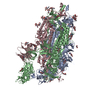
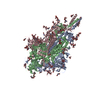

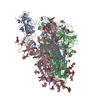


 PDBj
PDBj








